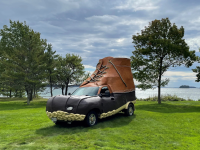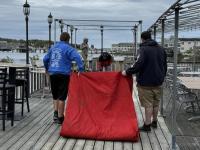Iraqi Freedom veteran explains how U.S. goes to war
 Maine Veterans Services Director Adria Horn talks about her military deployments to Iraq, Afghanistan and The Philippines Nov. 10 during the Boothbay Harbor Rotary Club's annual salute to veterans dinner. BILL PEARSON/Boothbay Register
Maine Veterans Services Director Adria Horn talks about her military deployments to Iraq, Afghanistan and The Philippines Nov. 10 during the Boothbay Harbor Rotary Club's annual salute to veterans dinner. BILL PEARSON/Boothbay Register
 Maine Veterans Services Director Adria Horn talks about her military deployments to Iraq, Afghanistan and The Philippines Nov. 10 during the Boothbay Harbor Rotary Club's annual salute to veterans dinner. BILL PEARSON/Boothbay Register
Maine Veterans Services Director Adria Horn talks about her military deployments to Iraq, Afghanistan and The Philippines Nov. 10 during the Boothbay Harbor Rotary Club's annual salute to veterans dinner. BILL PEARSON/Boothbay Register
A veteran of the Iraq and Afghanistan wars shared her experiences Nov. 10 as the Boothbay Harbor Rotary Club saluted the service of local veterans and the U.S. Marine Corps 241st anniversary. Maine Veterans Service Director Adria Horn, a 2001 graduate of the U.S. Military Academy, was the guest speaker. She served 11 years on active service duty which including deployments to Iraq, Afghanistan and Indonesia.
In 2011, she began her duties serving Maine veterans as a member of the U.S Department of Defense’s Veterans and Emergency Management team in Augusta. Horn told the approximately four dozen veterans at the Rotary Club the lessons she learned from her military career.
After graduation, she was commissioned as a second lieutenant. In Iraq, she served in one of two companies equipped with armored Humvees. Horn commanded a platoon originally headed on a security mission 90 minutes north of the Kuwaiti border. But when her platoon arrived in Iraq, the orders abruptly changed. Horn was re-assigned to leading an armored supply convoy to the recently fallen city of Baghdad.
“Literally 15 minutes before I was to go to Talil (Kuwaiti air base) my orders changed to take a different platoon to Baghbad delivering food, water and ammunition,” Horn said.
Further complicating the mission was the lack of directions to the Iraqi capital. She was told to take the two-mile-long convey to Kuwait City and ask directions to Baghdad — another seven-hour drive. Once the convey arrived in Kuwait City, a sergeant provided Horn with the best directions he could.
“He told me to keep driving until you see this, and pulled out a cocktail napkin, and drew a mosque on it,” she said. “Imagine that, a mosque! How many could there be in a Muslim country? And this is how America goes to war.”
Despite the sergeant’s directions, the convey got lost. Eventually, the convey reached Baghdad. The platoon found the city and Saddam Hussein’s presidential palace in disarray.
“(The palace) was left as if they were eating and left in the middle of meal. The tables all had plates of food so they probably didn’t vacate the place too long before we got there,” Horn said.
A few days later, the palace became the U.S. military headquarters for the Iraqi operation. Horn’s platoon handled the security for the building. During a press conference held at the palace, Horn’s platoon vetted the incoming journalists.
“We cleared the reporters for entering the briefing room, but at some point we had to cut off the number. There were about 20 reporters who didn’t get in including one Israeli who called me a bunch of names,” she said. “But I didn’t lose any sleep over it.”
A reporter allowed into the palace interviewed one of the remaining Iraqi occupants of Baghdad. She asked the well-dressed man if he was happy the Americans liberated the city. Horn recalled the man saying, “A month ago I had running water and now I can’t flush my toilet. So no, I’m not glad you are here!”
The man’s response provided Horn a different perspective of the Iraqi invasion.
“That was a wake-up call for me. I’ve always taken that with me and realize the real effect (a military operation) has on lives,” Horn said.
Later, Horn’s platoon provided security around the four primary check points around “The Green Zone” within Baghdad. The Green Zone was the city’s governmental command center during the American-led Iraq occupation. The experience shaped her opinion of how history is written. The platoon named the north checkpoint “North Gate.” But the southwest checkpoint didn’t have a gate, so the location was named after the patrolling unit. Its name became “Assassins’ Gate.”
After her deployment, Horn was in Missouri and heard about a new book titled “Assassin’s Gate.” She was told the title referred to the numerous assassinations near the Baghdad Green Zone during the American occupation.
“This is not how it got its name so I’m sharing a story with you how history is written. I chuckle every time I think about it,” she said.
Her final story was about her deployment to the Philippines. In 2009, the U.S. government granted Veterans Administration benefits to Filipinos who fought with Allied Forces during World War II. Filipino vets were required to apply for benefits at the U.S. Embassy in Manila. But Horn reminded her fellow veterans how difficult traveling around the island nation is. She estimated it took a year’s salary to travel from a rural island to the nation’s capital.
This resulted in American military personnel offering to forward applications from rural communities to Manila. Horn remembers one Filipino vet responding to a radio announcement for assistance. A five-foot-tall World War II Filipino vet dressed in his military shirt, garrison hat and pants arrived at the radio station carrying an American flag. He told U.S. personnel that he wasn’t there to fill out forms. The man who spent time in a Japanese POW camp simply wanted to meet Americans.
“He brought a flag presented to him by General MacArthur and he unfolded it for the first time when he met us. I couldn’t believe he was in awe meeting us,” she said.
The Rotary’s Veterans Day Dinner was also on the 241st anniversary of the U.S. Marines’ birthday. John Druce, 94, of Boothbay Harbor is the region’s oldest Marine and he cut the birthday cake.
Event Date
Address
United States


























